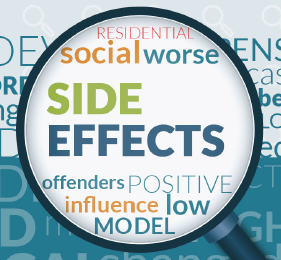This is the 5th of a 7 part series on The Risk Principle Simplified. Subscribe to our blog and get the series delivered right to your inbox.
Why would it make them worse?
All interventions have side effects. As some unfortunate cancer patients will attest, sometimes the cure is worse than the disease. Therefore, it is vital to consider the pros and cons of all interventions. Some of the down sides of residential placement for low risk offenders are as follows:
-
“The Social Learning Effect”: Low risk offenders tend to learn high risk behaviors and attitudes from high risk offenders. In practice, I have observed that high risk offenders tend to be stronger leaders, positive or negative, in group therapy sessions and residential environments. The well-intended idea of using low risk offenders as role models for high risk offenders is not likely to help the high risk clients, AND is likely to make the “role model” higher risk.
-
“The Ripple Effect”: When you place a low risk offender in residential, it has a ripple effect in the rest of their life. You take away their support system (that has, relatively speaking, been prosocial) and replace that social influence with a group of high risk offenders. Similarly, placing an offender in





